VW Passat
Front Brake Pads Replacement Guide
How to change the front disc brake pads
on a 2012 to 2015 Volkswagen Passat with the compatible part numbers.
By Paul B. Michaels Author & Photographer Auto Mechanic Since 1989 |
||
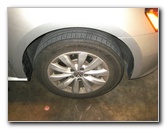 2015 Passat Front Wheel |
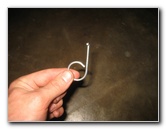 Lug Bolt Cap Removal Tool |
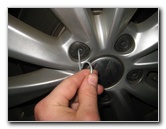 Black Plastic Lug Cover |
| This
automotive maintenance tutorial was specifically written to assist
owners of the 2012, 2013, 2014, 2015 and the refreshed 2016 NMS (new midsize sedan) VW Passat
TSI
in changing the front disc brake pads and lubricating the caliper
slider pins. Owners of other VW Group vehicles such as the Beetle, CC, Tiguan, Golf, Touareg, Jetta, GTI, SportWagen, Eos, Rabbit, Bora, Vento, Lavida, Coccinelle, Maggiolino, Fusca, Audi A3, A4, S4, A6, S6, A7, A8, Q5, Q7, A5, S5, and TT may also find these DIY instructions to be helpful. A few compatible replacement brake pads with their part numbers include the following: TRW TPC1375ES, Volkswagen 5N0 698 151 B, Wagner ZX1375, Centric 104.13750, Bosch BP1375, Monroe CX1375W, Bendix D1375, Power Stop Z23-1375 and Wagner ThermoQuiet MX1375. The tools needed to complete this procedure include a lug nut wrench, a floor jack, two jack stands, a large flathead screwdriver, a 7mm hex head socket or a 7mm Allen wrench, a "C" or "F" clamp and a tube of brake caliper grease. |
||
|
|
||
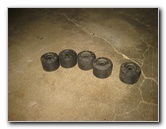 Lug Bolt Caps Removed |
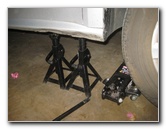 Raise Front of Vehicle |
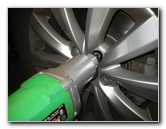 Remove 5 Lug Bolts |
| The first few steps
are to park the vehicle on a level surface, engage the emergency / parking
brake and chock both sides of
the rear wheels to prevent it from moving. Look under the cargo mat and locate the small silver metal tool with a loop on one end and a small hook at the other end. It is attached to the Styrofoam organizer near the floor jack and the lug bolt wrench. Insert the hook in to the middle of the black plastic lug bolt covers and gently pull them out. Set the five lug bolt covers aside in a safe place. (The tire iron / lug nut wrench in the trunk of this car was the wrong size, so I used my electric impact wrench with a 1 1/16" socket.) Slightly loosen the 5 lug bolts on the front wheel by turning them counterclockwise with the lug bolt wrench. |
||
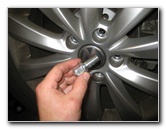 Lug Bolt Removed |
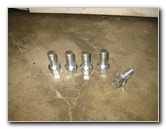 5 Lug Bolts (Nuts) Removed |
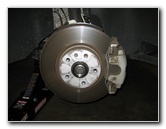 Front Rotor, Bracket |
| Raise the front of
the car with the floor jack and securely support it with the two
jack stands.
I prefer to work on one side of the car at a time for extra safety. Spin off the 5 lug bolts in the counter clockwise direction and set them aside in a safe place. Pull off the front wheel to reveal the front brake caliper, bracket, rotor and suspension. |
||
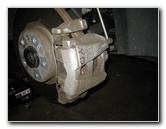 Front Brake Caliper |
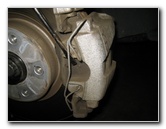 Metal Retaining Clip |
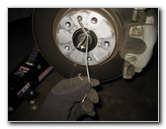 Pry Off Retaining Clip |
| I recommend wearing
safety glasses to protect your eyes during the next step. Carefully pry off the metal spring clip from the outer side of the front brake caliper with a large flathead screwdriver. Be careful since the spring clip may pop off and hit you in the face. It would be best to hold it with one hand while prying it off with the screwdriver. Set the spring clip aside in a safe place. |
||
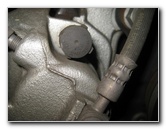 Caliper Bolt Plastic Cover |
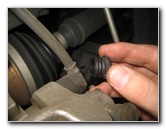 Remove Bolt Cap |
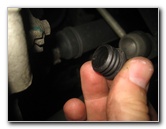 Remove Lower Cap |
| The front brake
caliper is held in place to the bracket by two combination bolt and slider
or "guide" pins which are located on the back side of the caliper facing in
towards the engine bay. Pry off the round black plastic dust covers at the end of the caliper bolt boots with your fingernails or a small flathead screwdriver. Once the plastic caps have been removed, you'll be able to access the 7mm hex head combination caliper bolts and guide pins. |
||
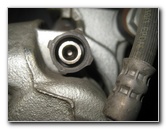 7mm Hex Head Bolt |
 Loosen Clockwise |
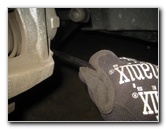 Loosen Lower Caliper Bolt |
| Loosen the upper and lower caliper bolts/pins by turning them clockwise (as seen from the outside of the car) with a 7mm Allen Key wrench or a 7mm hex head socket. | ||
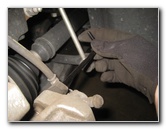 Spin Out Upper Bolt |
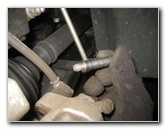 Caliper Bolt / Slider Pin |
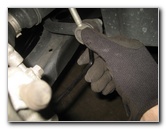 Spin Out Bottom Bolt |
| Continue spinning out the upper and lower caliper bolts and pins in the clockwise direction until they can be removed from the caliper. | ||
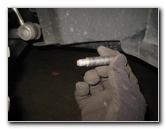 Bottom Bolt / Slider Pin |
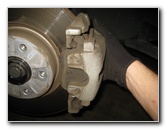 Pull Off Brake Caliper |
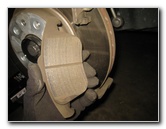 Remove Old Outer Pad |
| Set the two caliper
bolts / slider pins aside in a safe place. Carefully lift the brake caliper out of the bracket and rest it on top of the suspension or suspend it from the spring with a bungee cord or rope. Try to avoid pulling, stressing, kinking or bending the rubber brake fluid line. Pull the old outer brake pad out of the bracket. |
||
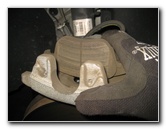 Pull Out Inner Brake Pad |
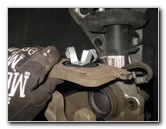 Three Prongs - Back Side |
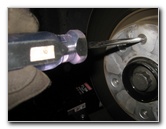 Rotor Set Screw Torx T30 |
| Pull the old inner
brake pad out of the piston in the caliper. It is held in place by three
metal prongs on the back side of the pad. If you are replacing the driver's side pads, you will need to disconnect the wire for the electronic wear indicator sensor. (Some Passat trim levels are not equipped with that feature.) I recommend buying the OEM Volkswagen 5N0 698 151 B front brake pads. In order for the caliper to fit over the thicker new pads, the piston will need to be pushed back in to the caliper body. |
||
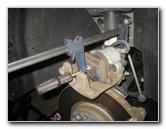 Attach "F" Clamp To Caliper |
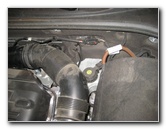 Brake Fluid Reservoir |
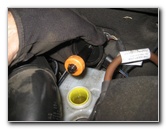 Twist Off Reservoir Cap |
| Attach the "C"
or "F" clamp to the caliper piston using the rear of an old brake pad to evenly
distribute the pressure across the piston. Move to the right rear area of the engine bay and locate the brake fluid reservoir. Twist off the round black plastic brake fluid reservoir cap in the counterclockwise direction. The reservoir is located near the right rear corner of the engine cover and to the left of the 12V car battery. Removing the brake fluid reservoir cap will allow the fluid to more easily travel backwards through the brake hose when you push back the caliper piston. |
||
|
|
||
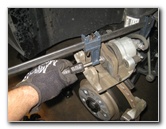 Compress Caliper Piston |
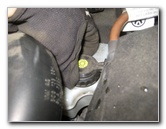 Replace Brake Fluid Cap |
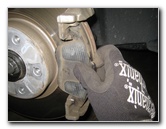 Install New Outer Pad |
| Slowly turn the "C"
or "F"
clamp handle in the clockwise direction to compress the piston back in to
the caliper while repeatedly checking the brake fluid level in the reservoir
to prevent it from overflowing. Clean up any spilled brake fluid immediately since it can easily damage painted surfaces. Continue compressing the piston until it is flush with the rubber dust boot surrounding it. Try to avoid pinching or damaging the rubber dust boot. Replace the brake fluid reservoir cap as soon as possible when you are done compressing the caliper piston since brake fluid is hygroscopic (absorbs moisture from the air). Twist on the cap in the clockwise direction.Apply a thin layer of synthetic brake caliper grease to any area where there is metal to metal contact such as the outer lip of the caliper piston. Do not apply brake parts lubricant to the friction surface of the new pads or to the face of the rotor. Thoroughly clean off the brake rotor, caliper bracket, brake caliper assembly and the lug nut studs with brake parts cleaner spray. Do not use compressed air or blow with your mouth to clean off the brake parts since breathing in brake dust can be harmful to your health. Brake dust can be carcinogenic (cancer causing) if inhaled.
To remove the existing rotors and install new ones, remove the single Torx T30 set screw on the front of the rotor and the two bolts on the rear of the caliper bracket that attach it to the steering knuckle. Then loosen the old rotor with a rubber mallet, pull it off, and slide the new one in its place. Replace the Torx set screw and tighten the two caliper bracket bolts. The service manual specification for the bracket caliper bolts is 89 lb-ft of torque. |
||
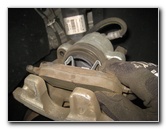 Push Prongs In Piston |
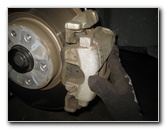 Lower Caliper Over Pads |
 Lubricate Slider Pins |
| Push the three
metal tabs on the rear of the new inner brake pad in to the opening in the
caliper piston. Install the new outer brake pad in to the caliper bracket. Carefully lower the caliper down over the new brake pads and line up the bolt holes in the caliper with their corresponding bolt holes in the bracket.In order for the caliper to operate smoothly, the smooth part of the two combination caliper bolts and slider pins need to be well lubricated. Apply a some brake parts lubricant grease to the smooth sections of each caliper bolt/pin. Do not apply lube to the threads at the ends of the bolts. |
||
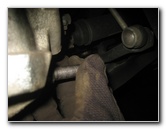 Re-Insert Pins / Bolts |
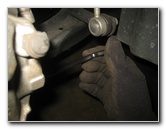 Spin In Counterclockwise |
 Tighten Caliper Bolts |
| Slide the two caliper bolts/pins in to the caliper and spin them in by hand a few turns in the counter clockwise direction (as seen from the outside of the car) with the 7mm Allen Key wrench or a 7mm hex head socket to prevent them from becoming cross threaded. | ||
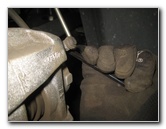 Torque To ~22 lb-ft |
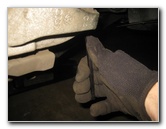 Double Check Both Bolts |
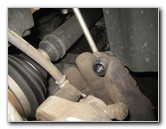 Re-Insert Plastic Caps |
| Then tighten the
two caliper bolts in the counter clockwise direction (as seen from the
outside of the car) to just past hand tight. The service manual specification for the caliper bolts is 22 lb-ft of torque (or 30 Nm). Double check that the two caliper bolts are tight before moving on to the next steps. |
||
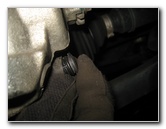 Push In Lower Bolt Cover |
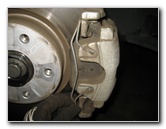 Re-Attach Spring Clip |
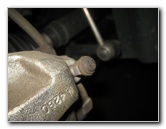 Rubber Valve Cover |
|
Push the black plastic covers back in to place over the rubber dust boots surrounding the caliper bolts/pins. Line up the metal spring clip over the outer face of the caliper and re-attach it. |
||
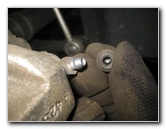 Brake Fluid Bleeder Valve |
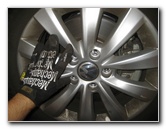 Replace Rear Wheel |
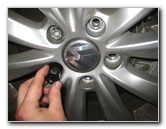 Spin In Lug Bolts |
| If your brake pedal
previously felt soft or spongy, the brake fluid might be contaminated with
water or the brake lines may contain a few air bubbles.
It would be best to bleed the brake lines at this time in order to flush out the old fluid and replace it with fresh DOT 4 brake fluid. For more on this topic, check out my Brake Line Fluid Bleeding With An Assistant DIY Guide or alternatively the Brake Line Fluid Bleeding With A Power Bleeder Guide. The brake fluid bleeder valve is located underneath a rubber cap on the back side of the caliper near the upper caliper bolt. Replace the front wheel and spin on the five lug bolts a few turns by hand in the clockwise direction to prevent them from becoming cross threaded.Slightly tighten the lug bolts with the lug nut wrench in a star or "criss-cross" pattern while the front of the car is still raised. Carefully lower the vehicle from the jack stands by using the floor jack. |
||
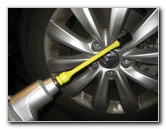 Torque To 103 lb-ft |
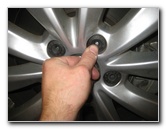 Push On Plastic Covers |
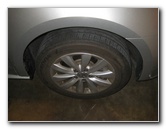 Front Brake Pads Replaced |
| Continue
progressively tightening the lug bolts in a criss cross or star pattern to
1/4 to 1/3 turn past hand tight or about 103 lb-ft (140Nm) of torque.
(Please double check your owner's manual for the correct wheel nut torque
for your vehicle.) It
would be best to use a torque wrench
or an electric impact wrench with a torque stick to properly tighten the lug
nuts. Sit in the driver's seat of the vehicle and firmly press the brake pedal a few times to restore the brake line pressure. Check the brake fluid in the reservoir and verify that it is at the proper level. If it is low, pour in some new DOT 4 fluid. To break in your new front brake pads, just drive normally for the first few hundred miles while trying to avoid any hard or "panic" stops which may glaze over the new pads and cause them to be noisy and/or not perform as well. It's also a good idea to regularly check your driveway for drops of brake fluid which may indicate a leak, check the brake fluid level in the reservoir, and also verify that the lug bolts are still tight. For more, check out all of my
Volkswagen Passat DIY Repair & Maintenance Guides. |
||
| If you found this guide to be helpful,
please consider making a small donation by clicking on the PayPal.com
"Donate" button located to the right of this paragraph. Thank you!
(Note: I am not a registered charity. Donations are not tax deductible.) |

